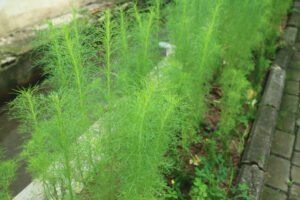How to Grow Asparagus

- How to choose and prepare the site.
- Where to buy healthy crowns
- How many crowns to plant
- How to choose the right cultivar
- Watering asparagus
- Fertilizing asparagus
- Asparagus pest
- Propagating asparagus
- Harvesting asparagus
- How to use and preserve asparagus
Choosing and Preparing the Site for Asparagus
Asparagus thrives in areas with full sun, so choose a location for your asparagus bed that receives at least 6 to 8 hours of sunlight daily. The soil should be well-drained, with a slightly alkaline pH level (between 6.5 to 7.5). Heavy clay or sandy soils can be amended with organic matter like compost or well-rotted manure to enhance fertility and improve drainage.
As for space requirements, each asparagus plant needs about 1.5 to 2 feet of space to grow properly. Keep in mind that asparagus is a perennial vegetable and a well-cared-for asparagus plant can be productive for up to 15 to 20 years or more. This means that selecting the right site and preparing it properly is especially crucial as it will be a long-term home for your asparagus crop.
Buying and Planting Asparagus Spears
When it comes to purchasing asparagus, it’s essential to buy one-year-old, disease-free crowns from reputable sources. This ensures that your asparagus bed gets off to the healthiest start possible. The best time to plant asparagus is in the early spring, as soon as the soil can be worked.
To estimate the number of plants you’ll need, consider your family’s eating habits. On average, each asparagus plant produces approximately 1/2 lb of spears per season. For a family of four where asparagus is a favorite, you might want to plant about 40-50 crowns to have an abundant supply throughout the season. Remember, the yield will increase yearly as the plants mature, providing you with a bountiful harvest for years to come.
When it comes to planting your asparagus crowns, the first step is to dig trenches that are approximately 12 inches wide and 6 inches deep. The width of the trench is significant as it allows ample room for the asparagus spears to grow and thrive without being overcrowded. The depth is equally important, creating an optimal environment for root development.
After your trenches are prepared, it’s time to place the asparagus crowns. Carefully set them in the trenches, ensuring they are spaced about 18 inches apart. This space is crucial to prevent competition for nutrients and water and it allows each plant to establish a strong, healthy root system. Remember, asparagus is a long-term crop, and giving each plant enough space is a vital part of ensuring a plentiful harvest for years to come.
Choosing the Right Asparagus Cultivar
Selecting the right asparagus cultivar largely depends on your climate, soil type, and personal taste preferences. There are several cultivars available, each with its own advantages and flavor profiles.
For cooler climates, the ‘Guelph Millennium’ is a popular choice. This cultivar, developed at the University of Guelph in Canada, is extremely winter hardy and has a high yield.
If you live in a region with longer, hotter summers, ‘Mary Washington’ is an excellent option. It is a well-known heirloom variety that’s been around for over 100 years and has good heat and drought tolerance.
For those who appreciate sweet asparagus, ‘Jersey Giant’ is another popular choice. This hybrid cultivar produces extra-large spears with an outstanding flavor profile.
No matter which variety you choose, it’s important to remember that asparagus takes up to three years to reach its full potential in terms of yield and flavor – so don’t get discouraged if your harvest isn’t very plentiful the first year or two! With proper care and patience, you’ll soon be enjoying an abundance of delicious spears each season.
Where to Buy Asparagus Crowns
Reputable sources for purchasing asparagus crowns include a variety of online and physical retail outlets. Online marketplaces such as Amazon and eBay often provide a wide selection of asparagus crowns. Specialty gardening websites like Burpee and Stark Bro’s also offer high-quality asparagus crowns. Be sure to read customer reviews and ratings before making a purchase to ensure you’re getting healthy crowns.
Local garden centers and nurseries are also excellent places to buy asparagus crowns. These locations allow you to physically inspect the crowns before purchasing, and knowledgeable staff can offer valuable advice on choosing the best crowns for your specific region’s growing conditions. Below are asparagus spears for sale on Amazon with good reviews:
Hand Picked Nursery Mary Washington 10 Live Asparagus Bare Root Plants -2yr-Crowns
Finally, many experienced gardeners have had success starting asparagus plants from seed. While this process takes much longer than purchasing crowns, it can be a cost-effective option for those on a tight budget. Seeds are readily available online and in gardening stores – just make sure you select varieties that are well-suited to your climate zone.
Care and Maintenance of Asparagus
After setting your asparagus crowns in place, you’re ready to backfill the trenches. Start by adding a mixture of compost and soil, which will provide abundant nutrients for the plants. Make sure to cover the crowns with a sufficient layer of this mixture, but avoid packing it down tightly – the goal is to create a loose, well-drained environment for the roots to grow.
Fertilization is also crucial for asparagus growth, and it’s best to use an all-purpose garden fertilizer. Apply the fertilizer according to the package instructions, taking care not to overfeed the plants as this can lead to weak, spindly spears.
Watering is another critical aspect of asparagus care. After planting, ensure the soil is always well-hydrated but not waterlogged. During dry spells, it’s essential to water your asparagus bed more frequently, ensuring the plants always have enough moisture to thrive. Remember, a well-tended asparagus patch can yield bountiful harvests for many years to come.
Dealing with Pests
Pests can pose a significant threat to your asparagus crop. Common asparagus pests include the asparagus beetle and the asparagus miner. The beetles can be hand-picked off the plants, or, for more severe infestations, an organic pesticide might be required. Asparagus miners, on the other hand, burrow into the stems of the plants and can be more challenging to control. One method of control is to remove and destroy infected plants. It’s also advisable to maintain a clean and weed-free asparagus bed, as this can help prevent the spread of these pests. Moreover, introducing beneficial insects, such as ladybugs and lacewings, can help naturally manage these pests. Always remember, vigilant and early detection of pests can significantly reduce the potential harm to your asparagus crop.
Harvesting Asparagus
Of course, one of the most exciting parts of asparagus gardening is harvesting your delicious crop. The best time to harvest asparagus spears is when they are about 6-8 inches tall with tight purple tips. To ensure a steady and abundant supply of asparagus for many years, only take 10 percent of the spears in each patch and leave the rest to mature. Make sure to use a sharp knife or asparagus knife, as opposed to snapping off the spears with your hands. To harvest larger spears, wait until they reach 10-12 inches in height before cutting them away from the plant.
Aside from eating it fresh, you can also preserve asparagus by pickling, blanching and freezing. With a little extra TLC, your asparagus harvest can last for many months to come!
Propagating Asparagus
When it comes to propagating asparagus, there are two main methods: from seed or from crowns. Growing asparagus from seed requires a bit more time and patience but can be a rewarding process. To start, sow asparagus seeds indoors 12-14 weeks before the last expected frost. Once they have grown into seedlings and the risk of frost has passed, you can transplant them outdoors.
On the other hand, asparagus crowns — which are one-year-old asparagus plants — can offer a quicker path to harvesting. To plant asparagus crowns, dig a trench about 12-18 inches wide and 6-8 inches deep. Place the crowns in the trench, spreading the roots out evenly, and cover them with 2-3 inches of soil. As the shoots start to grow, gradually fill in the rest of the trench with soil. This method can yield a harvestable crop in about two years.
Regardless of the propagation method you choose, make sure your asparagus plants are located in a sunny area with well-drained soil. They are a long-term investment and, with proper care, can produce spears for up to 20 years!
Final Thoughts
Growing asparagus is a great way to ensure you have access to this nutritious vegetable year-round. Whether you’re propagating from seed or crowns, it’s important to give your plants the right conditions for success. With ample sunlight and well-draining soil, your asparagus plants can thrive and provide delicious spears for many years to come. Plus, with the right variety, you can even enjoy a second harvest of asparagus during the late summer and early fall. So why not give this perennial crop a try? With proper care, your asparagus! crowns harvest can last for many months to come!
For more information on growing asparagus, be sure to check out your local nursery or gardening store. They can provide expert advice on the best varieties for your area and help you get started with the right propagation techniques. With a little effort and patience, you’ll soon have a bountiful crop of this nutritious vegetable in no time! Happy planting!


Resource: https://search.uada.edu/s/search.html?collection=uaex-search&query=how+to+grow+asparagus
For more gardening tips check here.

